|
Further photomicrography on stamps - SEMs, histology, botany, microbiology.
compiled by David Walker, UK
|
The number of stamps and philately related items featuring some aspect of microscopy, whether microscopes, microscopic subjects, microscopists are now into the many hundreds, so collectors of this thematic like myself often select small themes within the topic. See the Resources section below for topics that have been previously shared. Photomicrography was such a theme presented in an article twenty years ago on Micscape and this gallery provides an update on some recent issues that have particularly appealed to me and which are part of my modest collection.
|
Germany 2015, 2016, 2017 - SEMs
Germany have been issuing a pair of stamps annually in their Microwelten (microworld series) over the past three years. I'm uncertain if a new pair is planned or has been issued for 2018.
The subjects and magnifications of each false colour SEM are provided on each stamp and with the help of Google Translate and German Wikipedia for the less familiar subjects are from top to bottom:
Kieselalge 600X - diatom, Blüte Odermennig 40X - plant blossom (Agrimonia),
Strahlentierchen 420X - radiolaria, Fühler Nachtpfauenage 40X - moth antennae (Saturnia),
Vitamin C, Menschliches Haar - human hair.
Aspects of some subject designs extend into the stamp sheet borders.
As an aside on the knot in human hair, in the past I have occasionally felt a nodule in my own head hair strands and removed for closer inspection in case I was host to an unwelcome visitor of some type! Only to find that they were very tight knots as shown.
I'm intrigued how such tight knots form naturally as if hair of similar type is removed and knotted, it doesn't hold and loosens. Any insight welcomed!
|
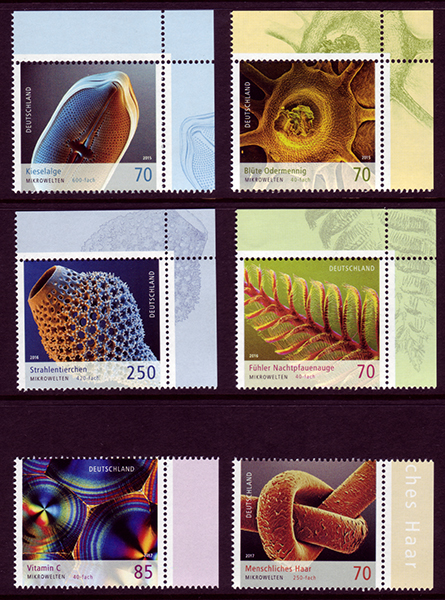
|
|
Greece 2018 - histology
I was delighted to learn of this very recent issue of five stamps from Hellenic Post on the theme "Science and Art through the microscope".
A press release on the Hellenic Post website provides background and details of the issue. The photomicrographer is "Maria Lambropoulou, Associate Professor of Histology-Embryology at the
Democritus University of Thrace Medical School". The stamp designs are credited to Marina Lasithiotaki.
The entire design of each stamp features histological specimens but each also has a clearly seen artistic aspect as well. The artistic elements are listed on the press release as "flowers, heart, wreath, deer, butterfly". From my limited collecting experiences, histology is not that common a subject for microscopy related thematics and more typically is seen as a smaller supporting feature on a stamp.
The splendid MEDinART website has a page devoted to Dr. Lambropoulou's 'Micro Life Art' plus a biography and her philosophy behind capturing the imagery. A number of histology photomicrographs with an artistic element are shown including those on the stamp issues. Each image has detailed captions giving both her popular titles, the technical details of the subject and
photomicrography equipment used.
The MEDinART webpage also includes a superb embedded YouTube video (5 mins.) showing sample preparation, her studies using the microscope and how the stamp issues have been presented in the philately issues.
|

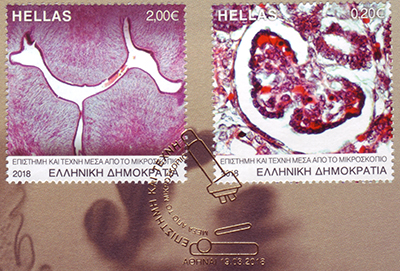
|
|
Two attractive covers were also issued as part of the set. The top cover design feature aspects of slide preparation, in itself an uncommon subject in microscopy thematics.
The postmark is an attractive gold embossed stylised microscope shown more clearly in the detail in the image of the stamp pair above .
|
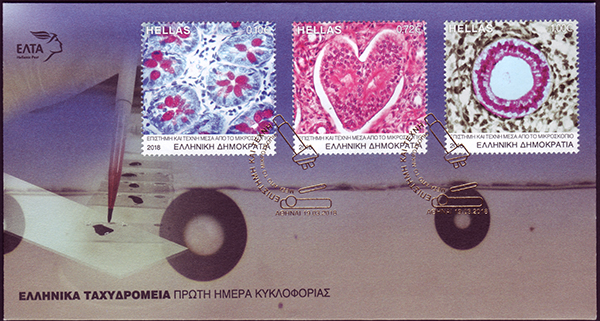
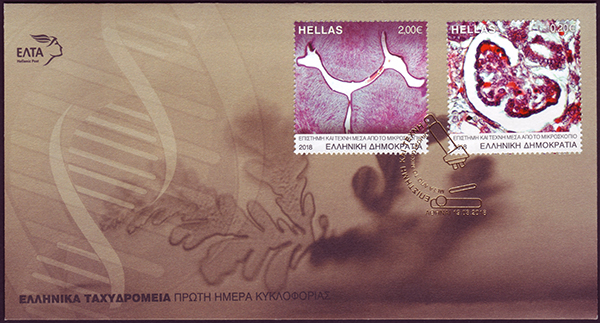
|
|
If the five stamps are bought as the unmounted set, they are supplied in this attractive multilingual leaflet that describes the background to the stamp issue, the photomicrographer and philatelic aspects of the issue.
Well done Hellenic Post and to Dr. Maria Lambropoulou for such a splendid celebration of microscopy and to illustrate how aspects can merge into artistry. Also for MEDinART for providing such informative and valuable background information.
|
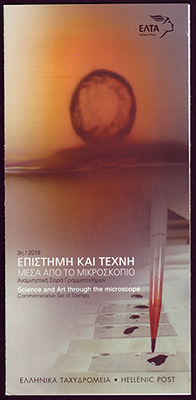
|
|
Japan 2017 - plant and animal tissues
This striking stamp sheet featuring two sets of five stamps was issued to celebrate the 100th anniversary of the founding of the Japanese Riken Institute (link is to the English 'About' page of the Institute). The sheet has a wealth of design elements reflecting aspects of the Institute's research over the years. The informative Philately
in Japan website has a page devoted to the issue and noting the design themes.
The stamp designs are credited to Tamaki Akira and the fourth stamp is described as showing 'plant and animal tissues'. One or more of the plant tissues may be related to the fifth stamp which reflects the work on creating a "new breed of cherry blossoms developed using heavy ion beams".
The sheet is also of interest as a physical chemistry thematic, one of my other collecting interests. The third stamp reflects the work on synthesizing the artificial chemical element Nihonium atomic number 113 and the design shows its synthesis and a decay sequence.
The Wikipedia entry for the element notes that it was "created in 2003 by a Russian–American collaboration at the Joint Institute
for Nuclear Research (JINR) in Dubna, Russia, and in 2004 by a team of Japanese
scientists at Riken in Wakō, Japan."
|
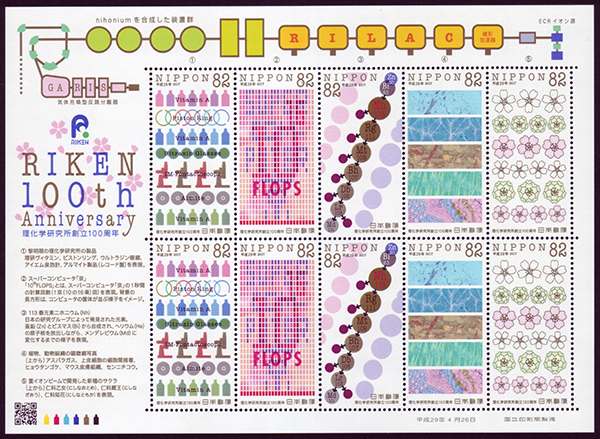
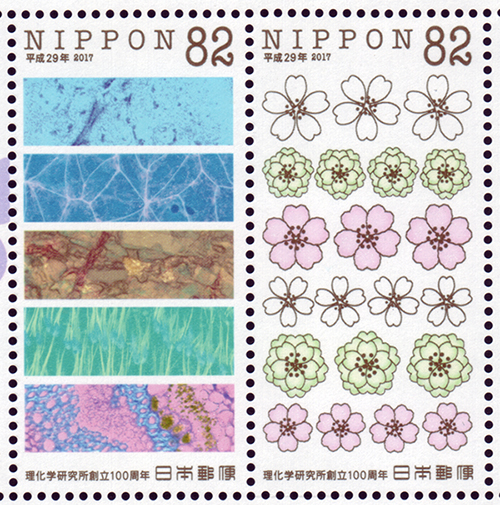
|
|
Netherlands 2011 - microbiology
This attractive sheet was issued to celebrate the centenary of the Nederlandse Vereniging Voor Microbiologie (Dutch Association for Medical Microbiology), link is to a Google translation of their website front page).
Each of the ten stamps features a photomicrograph of an organism relevant to microbiology taken with either an optical or electron microscope. the subject and a comment on each is in the border next to each stamp. The subjects are (own comments for unfamiliar organisms with the aid of Wikipedia):
Bacteriophage, Anammox bacteria (anaerobic methane oxidation)
Rhizobium (nitrogen fixing bacteria),
Lactococcus lactis (bacterium used for dairy products)
Saccharomycees cerevisiae (yeast used in brewing and baking), Bacillus
Aspergillus niger (black mould),
Tetraselmis suecica (green alga, 'aquaculture foodstock')
Methanosarcina (methane producing archaea), Penicillium
|
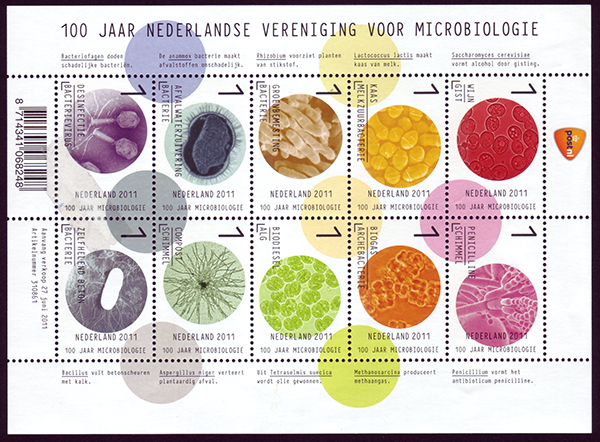
|
Comments to the compiler are welcomed.
Acknowledgements
Thank you to René van Wezel for drawing my attention to and for kindly donating the Netherlands stamp sheet.
Micscape Resources
Micscape articles on microscopes / microscopy on stamps.
Selected topics in microscopy, photomicrography, diatoms, radiolaria, Van Leeuwenhoek / Robert Hooke and marine plankton / oceanography by
David Walker.
Microscopes
and Stamps by Fritz Schulze.
External resources
Image acknowledgements. The copyright of the stamps and envelope designs remain with the postal issuing authorities and/or the designers and have been credited where known. They are presented here at a limited size solely as an educational resource on this
not-for-profit website. If a copyright holder wishes to contact the author please use the email above. Thank you.
Sourcing stamps. For readers interested in seeking out one or more of the stamps on the above or other topics, one of the best portals for thematics is delcampe.net. Catalogue numbers aren't needed and often not stated. Searching for country with year and keyword of theme can usually show all the dealers offering them. Where not
offered on delcampe.net, eBay is the second choice.
©
Microscopy UK or their contributors.
Published
in the September 2018 edition of Micscape.
Please
report any Web problems or offer general comments to
the
Micscape
Editor
.
Micscape
is the on-line monthly magazine of the Microscopy UK web
site at
Microscopy-UK
©
Onview.net Ltd, Microscopy-UK, and all contributors 1995
onwards. All rights reserved.
Main site is at
www.microscopy-uk.org.uk.








